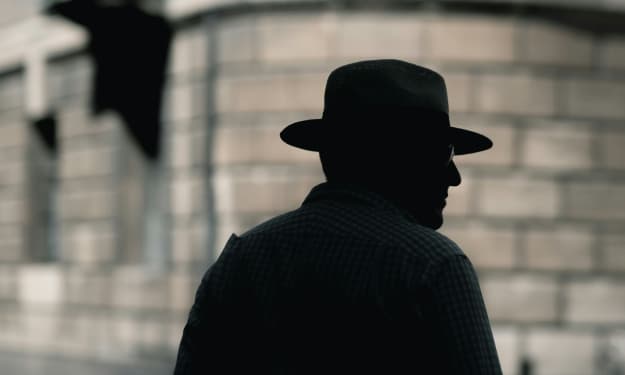He Murdered The Air Controller Who Crashed The Plane In Which His Family Was Going
Solved

Today’s case begins in Barcelona, where 46-year-old Vitaly Kaloyev lived on July 1, 2002. The man was a Russian architect and had been in the city of Barcelona for 7 months building a house for a rich guy who had hired him.

That day Vitaly was in a very good mood because he was going to meet again with his wife Svetlana and her two children aged 10 and 4.

The plan was to pick up his family at the airport who were arriving on flight 2937 of the Russian company Bashkirian Airlines. But unfortunately the plane never landed.

That day there was the so-called Lake Constance accident in which two planes were involved and one of them was the one in which Vitality’s family was traveling.
According to several media at 9:30 p.m. over the city of Uberlingen, two planes crashed when they received contradictory information.
While the Bashkarian Airlines plane had an order sent by the ground controller to descend from its flight level, the other belonging to the DHL company received the order from its TCAS system to make exactly the same descent to the same flight level.
That day there was only one flight controller handling the airspace. It was Peter Nielsen.

The accident:
Minutes earlier Peter realized that both planes were dangerously next to each other so he contacted flight 2973 to tell the pilot to descend the plane about 300 meters and thus avoid the collision.
Contrary to the controller’s instructions, the Traffic and Collision Evasion Warning System (TCAS) told 2937 to ascend.
In case of contradictory instructions, the Russian pilots were trained to ignore the TCAS and obey the control tower. The problem was that the DHL flight did not receive the verbal instructions and also began to descend.
When both pilots realized what was happening, it was too late. The impact of the aircraft was so tremendous that the DHL plane first left through the central area and then exploded.
The other plane was less damaged and in fact was able to continue in the air for two more minutes until it finally rushed to the ground.
According to the black boxes, the Russian plane noticed the presence of the cargo plane 8 seconds before the accident, which is why it was able to avoid a total collision between both planes, but not enough to change the necessary altitude and thus save both ships.
While the DHL flight was manned only by pilot Paul Philips and co-pilot Brant Campioni, on Bashkarian Airlines flight 2937 it was traveling with 69 people, most of them teenagers who were going on a school trip to Spain through a UNESCO initiative.
Among them was Vitality’s family.
The investigation:
Vitality was one of the first relatives to arrive in Überlingen, the scene of the accident. Devastated by what happened, he tried to look for his loved ones.

The plane had crashed from the top, which led to the bodies of the passengers falling in different places.
Svetlena’s remains were found by the authorities in a cornfield and those of his eldest son in an old bus parking lot.
The architect had the hope of finding his daughter Diana alive, which led him to spend the following weeks looking for her, but unfortunately there was no luck. Finally, in the area marked as the accident, he located a pearl necklace of his daughter and then they found her body.
A few months later, the investigation of the Federal Office of Aeronautical Accidents of Germany concluded.
Based on the data obtained by the black boxes, it was determined that the training of the Russian pilots influenced the accident because by receiving contradictory orders they ignored the recommendation of the TCAS. Not to mention that no one contacted DhL’s plane to give him instructions.
On the ground, they also investigated the personnel who were present at the operations center confirming that there was only one air traffic controller.
Peter Nielsen, was alone in front of several radars. It was known that the work overload caused the take-off of an Airbus 320 at Zurich airport to lose focus. Apparently the impossibility of attending both flights effectively along with the lack of communication with other approach points caused him to deliver a temporary order to the Russian plane, generating the contradiction in the air.
The official investigation concluded that despite the negligence, the air traffic controller had to be released from charges. They also kept him in the company called Skyguide, although Nielsen had already made the decision to retire and dedicate himself to his wife and children.
The murder:
On the first anniversary of the tragedy, Vitality asked one of the skyguide bosses if he could meet the controller responsible for the disaster, however he did not receive any response.
Vitaly’s brother declared that after the accident the man had suffered a nervous breakdown that led him to live for almost two years in the cemetery sitting behind the graves of his wife and children.
At that time his obsession was to try to clarify the facts, but as time passed and seeing that officials denied him access to information, his pain turned into rage.
The Skyguide company offered him just over €100,000 for the death of his family in exchange for putting an end to his own investigation or future demands.
Putting a price on the deaths of his wife and children was the straw that broke the camel’s back so furious Vitality hired a private investigator in Moscow to find the address of the controller in Switzerland.
This detective got Peter Nielsen’s address so without thinking twice Vitalty traveled to Zurich and stayed in a hotel that was near the airport. This hotel was chosen because it was very close to the house. Peter lived with his wife and children.
According to the staff of the Vitality hotel, they did everything possible to go unnoticed. The manager said that he was very calm and that during the two days he was there he stayed in his room. To this he added that he did not know much English and that at breakfast he looked at brochures that offered tours to visit the city.
On February 24, 2004, the architect left his room and went to Peter’s house. When a neighbor arrived there and saw him in the vicinity of the house, she asked him what he wanted.
Vitaly waved a paper with Nielsen’s name and she pointed him to the house where he lived. Instead of knocking on the door, the man sat on a bench and waited in the front yard.
Peter had just returned from a work trip and already inside his house he noticed the man’s presence. El Controller came out to ask him what he wanted and without realizing it behind him his three children also came out.
A few seconds later his wife called them to enter, and it was at that moment that she heard a noise in the garden.
The woman ran out and found her husband lying on a large pool of blood. According to several witnesses before that, the victim and the murderer had a brief conversation.
Nielsen’s wife saw her husband’s assailant fleeing. The 36-year-old man suffered multiple stab wounds and a few minutes later he died in the presence of his family.
With the description of the attacker and knowing that of the threats that Vitality had made to the Skyline workers, the agents focused on the man as the main suspect.
On the same day of the events, he was found in the hotel in Zurich in a state of shock and unable to remember what he had done.
The trial:
In 2005, the trial for the murder of Peter Nilsen began. Vitality stated that the accident ended his life and added that his children were the youngest passengers who were traveling on that plane.
To this he added that he went to Peter’s house to ask him to apologize for the death of his family, but that instead the controller hit him in the hand in which he carried his photographs.
This gave him such a disturbing feeling that he decided to end his life. What he couldn’t explain was why he took a gun to the man’s house if his plan was peaceful.
Finally, on October 26, 2005, Vitality Kaloyev was sentenced to 8 years in prison for the murder of the controller.
It is known that in 2007 the architect was released due to pressure from Russian officials and also because it was determined that he was mentally unstable, something that by the way was not reflected in the initial sentence.

Vitaly was released from the Swiss prison and when he arrived in Russia he was received by a large crowd as a hero.
Upon arrival, members of a Russian organization dedicated to helping the relatives of the victims of the plane crash declared the following:
“Kaloyev is a hero since those guilty of causing plane crashes often go unpunished. Such a radical punishment is the only way to hold them responsible for their crimes.”
Many Russians shared that feeling and believed that the man committed a heroic act that avenged the death of his family.
Despite the accident and subsequent murder, many years passed before improvements were made to aviation systems. Improvements that brought a new TCAS system, and thus help to avoid future collisions.
Thank you for reading the case and subscribing❤️
About the Creator
Based On a True Story
Hi everyone! My name is Marta and every week I write about true crime, always with an educational purpose.






Comments
There are no comments for this story
Be the first to respond and start the conversation.